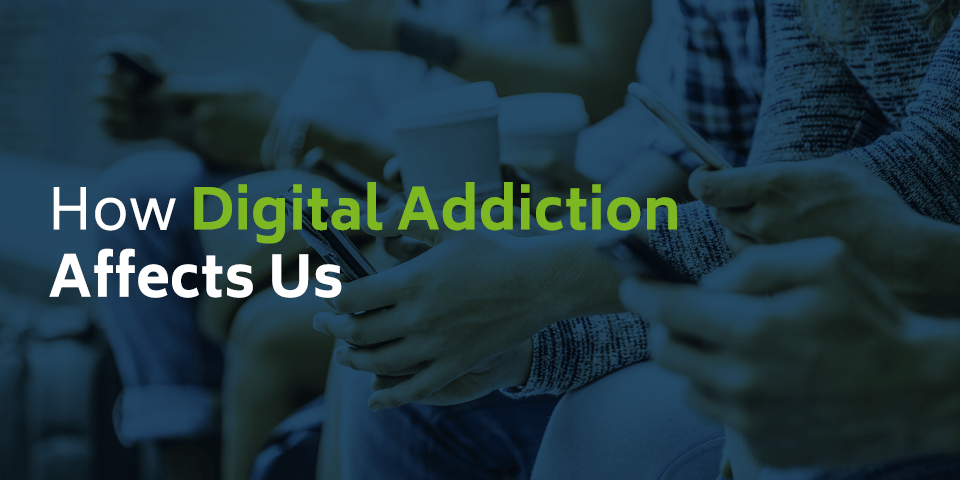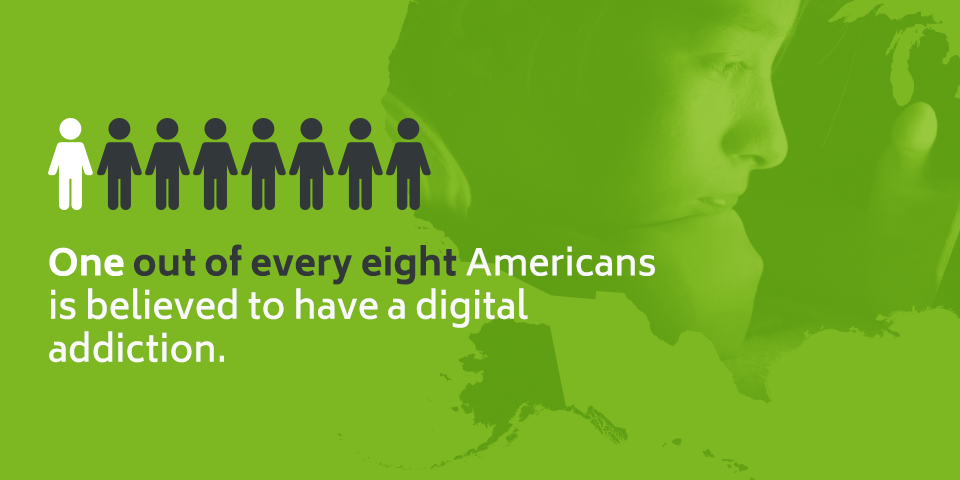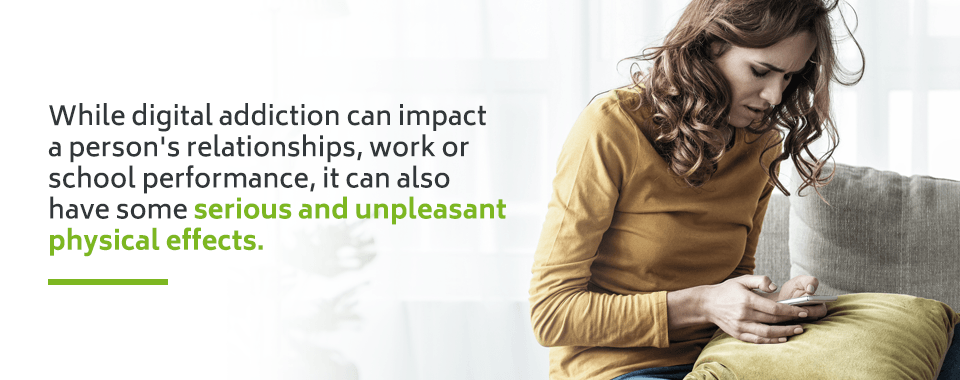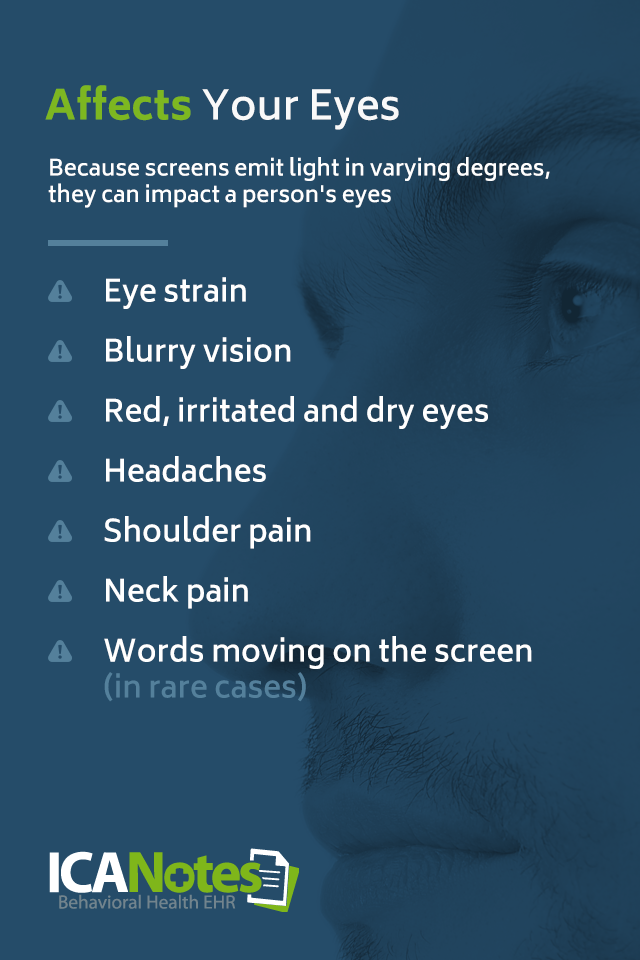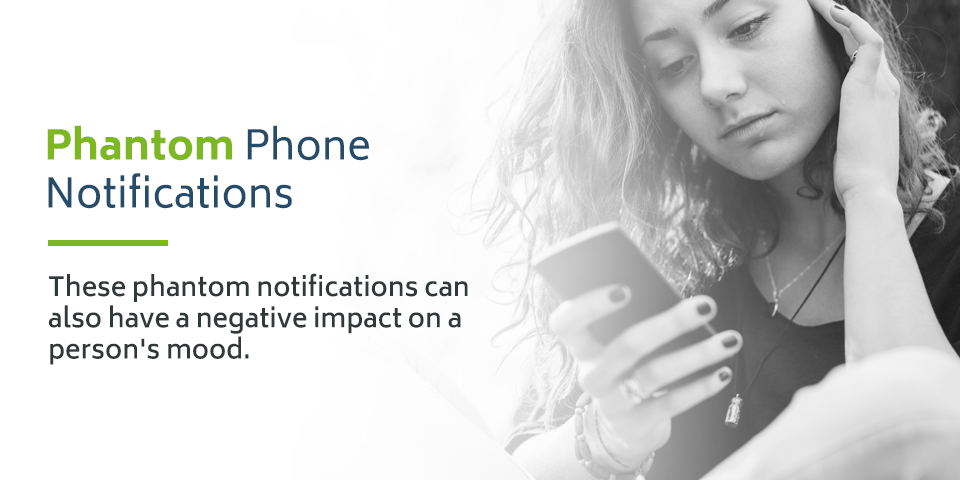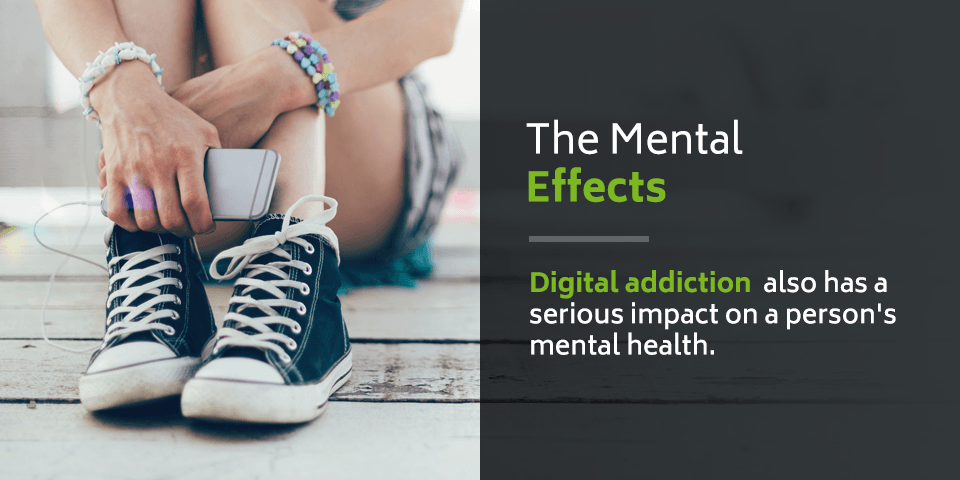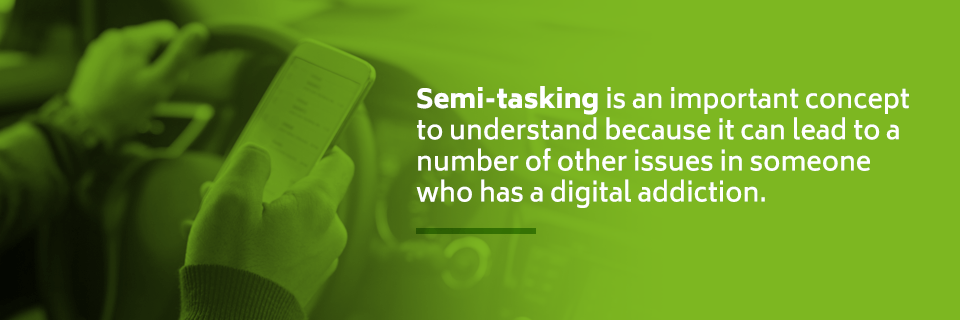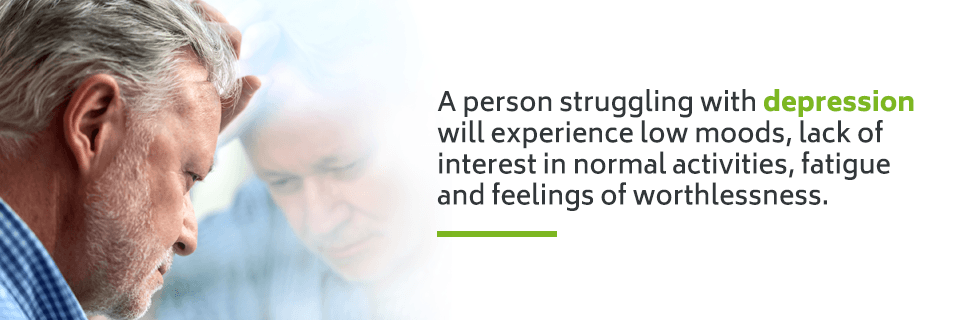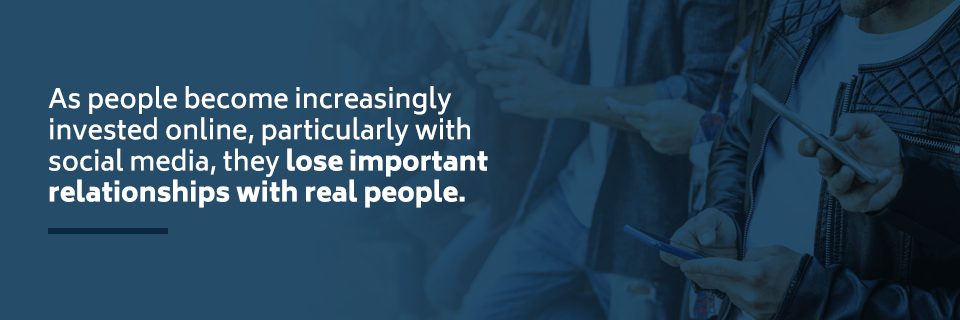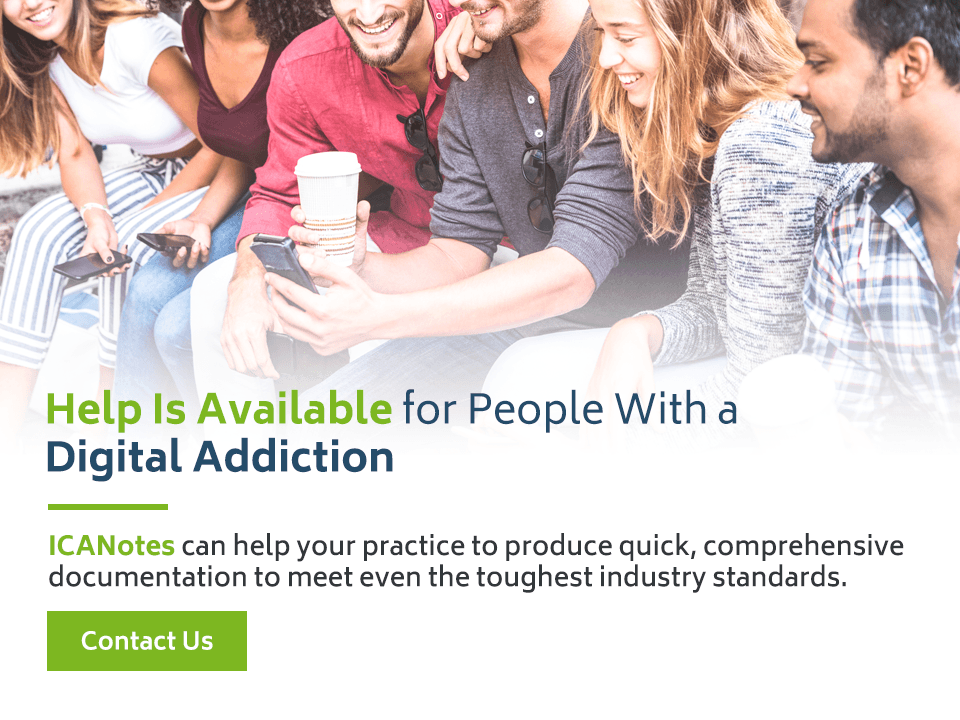How Digital Addiction Affects Us
Phones and digital technology have completely altered the way we live our lives. Now, we use the internet to communicate with friends, watch television, do our banking and even get ahead at work. Phones and other digital devices have become so prevalent in daily life that many people would even say they can’t survive without their phones. The term “addicted” gets tossed around a lot when it comes to phones and digital devices, but the truth is that a dependence on technology is not the same as a true addiction.
For most people, dependence on their digital devices is something they can take care of with a little bit of willpower and by using technology that has been developed to help regulate digital use. But there’s a smaller group of people who aren’t able to take the same steps. No matter how hard they try, these individuals cannot stop using their devices. They derive meaning from their online activities — particularly online gaming — and eventually find that they cannot stop their online activities even if they try.
While it hasn’t been classified by the United States as a mental disorder, digital addiction has gained increasing attention from researchers, the media and the general public because its impact on a person’s brain, health and overall wellbeing is increasingly clear. In fact, a number of other countries — including India, Italy, Japan, China and Taiwan — have declared that digital addiction is a public health crisis.
How to Identify Digital Addiction
One out of every eight Americans is believed to have a digital addiction. This type of addiction can encompass a variety of activities but is most commonly used to describe someone who is excessively engaged in online gambling, gaming, pornography, online shopping or social media. The term is also used for someone who is addicted to their smartphone in general, meaning they use it all the time and can’t stop.
Because smartphone and internet use are a part of daily life for most people, it can be difficult to spot an addiction. The difference comes in how a person responds to their online activities, as well as how they respond when their activities are interrupted. While the signs and symptoms may vary, in general, a person’s use of technology may have crossed from average to addiction if they:
- Opt to spend time alone with the computer, tablet or smartphone rather than socialize with family or friends
- Attempt to hide or minimize the phone or computer screen when another person walks into the room
- Become defensive when confronted about online activities
- Prefer the company of their online friends and peers over family or friends in person
- Receive low grades or negative evaluations at work because of their isolation or inability to keep a schedule
- Spend a lot of time talking about their online activities
- Derive feelings of self-worth and meaning from their activities
- Neglect household chores and responsibilities
- Display increased feelings of anxiety or agitation
In extreme cases, someone with a digital addiction may lose their job, fail a class or find themselves in legal trouble as a result of their online activities.
Some people compare digital addiction to an extramarital affair because it happens when a person withdraws from the support of their spouse or friends and family in favor of something new — in this case, the internet.
The Physical Effects
While digital addiction can impact a person’s relationships, work or school performance, it can also have some serious and unpleasant physical effects.
Promotes Poor Posture
Studies have shown that prolonged use of a cell phone can result in a condition called sustained forward neck posture. This issue happens when a person regularly extends their neck and upper spine because they’re looking down at their phone. Over time, it can injure the lumbar and cervical spine as well as certain ligaments. In other words, using your cell phone can change the way you hold your head and your neck, causing long-term pain and leading to other health problems, including respiratory issues, headaches, neck pain and more.
So how does a digital device cause so many problems? It happens because most people don’t pay attention to their posture when they’re scrolling through Facebook or texting a friend.
On average, the human head weighs 10-12 pounds. When you tilt your head forward and down to look at something, the amount of pressure put on the joints and muscles in your neck and back equates to more weight. For example, if you tilt your head forward just 15 degrees, it’s the equivalent to increasing the weight of your head to 27 pounds. If you tilt it to 30 degrees, that’s as if your head weighed 40 pounds. Forty pounds of pressure is significant, especially if you’re repeating the motion many times a day.
When you consider that the average American spends almost 24 hours a week online, you can see how serious these statistics are. Digital addicts are online even more, so they’re putting a strain on their neck and spine for more than one full day every week. Over time, this behavior can do serious damage to the neck and back.
Affects Your Eyes
Eye strain is becoming an increasingly common problem among adults and children who regularly use digital devices. Because screens emit light in varying degrees, they can impact a person’s eyes. Some people have more problems than others, but a recent survey found that 70 percent of adults in the United States have experienced some of the symptoms, including:
- Eye strain
- Blurry vision
- Red, irritated and dry eyes
- Headaches
- Shoulder pain
- Neck pain
- Words moving on the screen (in rare cases)
These symptoms are the result of prolonged screen time, but there’s no solid number on how much screen time is too much. Some people spend several hours in front of a screen before they begin to experience a problem. Others start to notice some of these symptoms after only 10 minutes at the computer.
While digital eye strain — also known as computer vision syndrome — is not a permanent condition, it does cause a lot of discomfort. And while there’s still a lot of research to be done, there’s some information out there indicating that the blue light that emits from digital screens can lead to long-term vision problems.
For someone who’s addicted to their smartphone or computer, digital eye strain may become an ongoing problem. Because there’s much that isn’t known about its long-term effects, prolonged screen time comes with some risks.
Hand Cramps From Holding
Ever heard of the phrase “text claw”? It’s not technically a medical term, but text claw is an increasingly common phrase used to describe what happens to a person’s hands and wrists when they use their smartphones a lot.
When a person is using a cell phone, they’re using their fingers, hands and wrists in repetitive motions. They’re scrolling, texting and clicking over and over again. Not only that, but the actual act of holding the phone engages fingers, hands, wrists and even the forearms. That’s a lot of muscles and tendons and ligaments being used over and over again.
If you use a smartphone a lot, you may start to notice that you have some cramping and discomfort in your hands and wrists. For most people, it’s no big deal. Doctors simply advise that they take breaks from their phone and do simple stretches to relax their muscles and tendons. In some cases, a person may even benefit from using a brace on their wrist.
For someone who’s addicted to their smartphone, hand cramps and pain from cell phone use can become a big deal. While text claw isn’t the same as tendonitis or carpal tunnel syndrome, if it’s not addressed, it can eventually turn into one of these more painful and serious conditions. It can also permanently weaken the muscles in the wrist and hands, eventually leading to a loss of mobility.
Phantom Phone Notifications
Everyone has had times when they thought they heard their phone beep or mistakenly felt it vibrate only to find out that they imagined it. Experiencing this occasionally is no big deal, but if it happens daily, it may be a sign of digital addiction.
A person who’s addicted to their smartphone is always waiting for notifications. They constantly check their phone or think they heard it make noise. If they’ve turned their phone off during a meeting or class, they may become anxious thinking about what’s going on with their phone and what notices or messages might be waiting for them.
Besides the inconvenience of constantly waiting for a notice, these phantom notifications can also have a negative impact on a person’s mood. According to a joint study between Indiana University and Purdue University, 89 percent of students who were surveyed reported that they had experienced phantom vibrations or notifications that resulted in feelings of anxiety or becoming upset when they realized there was not a notification or message on their phone.
In other words, experiencing phantom notifications led to negative, stressful feelings that impacted their overall mood. As we’ll discuss later, these feelings can lead to anxiety, agitation or depression, which are serious and should not be taken lightly.
Bacteria-Caused Blemishes
Did you know that your phone contains more bacteria than a toilet in a public restroom? That’s right. The device you hold in your hand, place next to your ear and set on your kitchen counters is just swimming with gross stuff. Why? Because most people don’t clean their phones on a daily basis. We take our phones to the bathroom, set them down on public surfaces and touch them after touching other uncleaned surfaces.
The average cell phone contains traces of the cold and flu virus, meningitis and staphylococcus. It collects traces of makeup, oils from our skin and dirt from the places we go. Over time, this combination builds up and creates a dirty phone surface that can aggravate acne and eczema. While it doesn’t cause these conditions, it can make them worse for people who already struggle with them.
Still not convinced that it’s a big deal? People who struggle with acne have lower self-esteem and are at a higher risk for depression. In fact, acne sufferers have been found to have emotional and psychological issues that are comparable to people who suffer from diabetes and arthritis. So while a few pimples might not seem like a big deal for the average person, acne can have serious mental health implications for someone who’s addicted to their smartphone.
The Mental Effects
Not only can digital addiction lead to a number of physical health issues, but it can also have a serious impact on a person’s mental health.
Feelings of Guilt
When a person develops a digital addiction, they’ll often experience deep and intense feelings of guilt, which is the feeling that a person has failed with an obligation or done something wrong. As their digital addiction progresses, they may forget dinner with a friend, miss a child’s school play, fail to turn in a report at work or even miss their anniversary. Depending on the specifics of their addiction, they can even fall into debt from online gambling or destroy a relationship because of an addiction to pornography.
While the specifics may vary, these actions can generate intense feelings of guilt. After all, the person has let someone down, failed to accomplish a goal or, in extreme cases, hurt someone else. It’s inevitable that they’ll have feelings of guilt over these outcomes. Even if they don’t show it, they likely feel bad that they’re hurting the people they love. They may worry because they’re in financial trouble, and they know they’re not behaving the way they should.
Someone with a digital addiction most likely won’t admit that they feel guilty about it because then they’d be admitting that they have a problem. As with any kind of addiction, they want everyone to believe they have it under control. Even if they don’t admit it, however, the guilt is most likely present in some form.
The danger comes over time. As a person continues to feel guilty, they can eventually fall into depression. Because they don’t want to admit that they have a problem, they may try to cope with their depression by turning to the one thing that makes them feel good — their digital addiction. And the cycle continues.
Anxiety
While digital addiction is still not classified as a mental health disorder, many believe that it stimulates the chemicals and receptors in the brain that generate feelings of pleasure. The more a person uses their smartphone or the internet, the more they seek out the feelings of pleasure they get from their online activities. This process will spur them to spend more time on their online activities to replicate the “high” they’ve experienced in the past.
Earlier, we mentioned that phantom phone notifications can lead to anxiety because a person frequently imagines that they hear their phone. Another source of anxiety for someone with a digital addiction comes when they’re away from their phone or computer. They’ll obsess over what they’re missing, whether it’s a conversation over social media, a bet they made gambling or a deal they’re watching on eBay.
Not only does digital addiction result in anxiety from what a person is missing, but it can also cause anxiety because of something called semi-tasking. In today’s world, many people use their devices in conjunction with other activities. They text a friend while folding laundry. They surf the web while they eat breakfast. They check football scores while they wait for a meeting to start.
This process of semi-tasking adds to the amount of time it takes to complete a task, and it also means that individuals never have the chance to decompress or relax between activities. There’s always something demanding — and dividing — their attention, which means none of their tasks are being done well.
Semi-tasking is an important concept to understand because it can lead to a number of other issues in someone who has a digital addiction. When a person is constantly engaged, they never have time to relax and recharge. They never unplug or step back from their daily life because they’re constantly being bombarded with their online activities.
Depression
While anxiety and depression are often discussed simultaneously, they’re two very different conditions. A person struggling with anxiety will experience feelings of restlessness, worry, irritability and tension. A person struggling with depression will experience low moods, lack of interest in normal activities, fatigue and feelings of worthlessness.
For a person with a digital addiction, both anxiety and depression are often intertwined with their addiction. Not only do people who suffer from anxiety or depression often turn to the internet for relief from their symptoms, but someone who has a digital addiction is at a higher risk of developing anxiety or depression.
Anxiety stems from the constant demands of the online world. The allure of the digital world is more than someone who’s addicted to it can stand. Depression, on the other hand, can happen when a person does not get the “high” they normally experience from their online activities. In fact, digital addiction and its effects have been compared to the high that comes from taking opioids — and when an addict doesn’t have it, they can experience low moods, feelings of hopelessness and sadness.
As we mentioned before, over time, intense feelings of guilt can also lead to depression. As a person continues to hurt themselves or their loved ones with their addiction, their guilt may transform into low moods, lack of interest in their activities and more. They may find that they don’t experience pleasure in the things that used to bring them joy. Over time, their depression may grow.
Isolation
Often linked to anxiety and depression, isolation is a huge problem in today’s digital world. As people become increasingly invested online, particularly with social media, they lose important relationships with real people. They opt for screen time over face-to-face time. They rely on their online world for affirmation. But the problem with online relationships is that there’s no way to read body language and social cues that are present in face-to-face interactions. There’s no physical contact, no verbal cues and no personal communication, all of which are essential components of human relationships.
Not only does digital technology cut out some essential aspects of human interaction when two people communicate via text or social media, but it can also have a negative impact on people interacting face-to-face.
When two friends are having lunch and one of them hears their phone go off, they have the choice to answer it or ignore it. Depending on the circumstances, their decision to check a notification may cause hurt feelings. While students wait for class to start, they surf Facebook rather than chat with their classmates. While parents sit at soccer practice, they browse Amazon instead of engaging with other parents.
Smartphone use has also been found to have a negative impact on parent-child relationships when a parent is overly distracted by their phone, causing children to feel distress and isolation.
Agitation
Similar to the anxious feelings someone gets when they can’t see or hear their smartphone, someone who has a digital addiction may become increasingly agitated when they’re not near their phone or computer. Agitation is nervous excitement or arousal usually displayed in physical motions and movements. An agitated person is restless and emotionally on edge. They may be easily provoked to anger or suddenly experience an emotional meltdown.
Agitation occurs when a person is unable to satisfy the urges that their addiction creates. For example, if a person who is addicted to their smartphone were to break their phone and suddenly be without one, they may be quick to get angry when someone cuts them off in traffic or criticizes their work performance. Perhaps a woman has begun an online affair and is delayed from getting online to converse with her new love interest. She may burst into tears when a friend cancels lunch or find that she cannot think clearly enough to give an important presentation at work.
In these and other cases, the result is increasing agitation because nothing else will satisfy their brain’s need for the stimulation and pleasure that comes from a digital addiction. Outbursts can be sudden and extreme, and they can be scary and confusing for loved ones, particularly those who aren’t aware of the addiction or its severity.
Outbursts are not the only sign that a person is agitated. The individual may also become restless and feel an insatiable need to pace or move around. They may not be able to sit still, or they may talk a lot. They could refuse to do things they normally do without complaint. All of these activities are a response to their need to fulfill their digital addiction.
Help Is Available for People With a Digital Addiction
It can be easy to write off a digital addiction. After all, everyone spends a lot of time on the internet these days, right? But if someone you love is displaying signs that they’re addicted to some form of digital technology, they need help. Finding a reputable addiction counselor or addiction recovery center with experience in treating digital addictions is the first step to helping someone with a digital addiction.
Offering a state-of-the-art charting system for behavioral health professionals, ICANotes can help your practice to produce quick, comprehensive documentation to meet even the toughest industry standards. When you use ICANotes, you’ll reduce your time spent on documentation, allowing your practice to spend more time bringing in clients. For a free software trial, contact us today.
Related Posts
Strategies for Reducing Stress, Anxiety and Burnout in the Workplace
What Are the Most Common Mental Health Disorders in the United States?
How Mobile Devices Impact Patient Satisfaction
Ways Exercise Can Improve Mental Health
Sources:
https://www.digitaltrends.com/mobile/google-research-jomo/
https://www.cnn.com/2016/05/03/health/teens-cell-phone-addiction-parents/index.html
https://www.cnbc.com/2017/08/29/us-addresses-internet-addiction-with-funded-research.html
https://virtual-addiction.com/warning-signs-of-internet-addiction/
https://www.technologyreview.com/the-download/610045/the-average-american-spends-24-hours-a-week-online/
https://www.spineuniverse.com/wellness/ergonomics/your-cell-phone-killing-your-back
https://www.ncbi.nlm.nih.gov/pmc/articles/PMC4756000/
https://www.usatoday.com/story/news/nation/2014/01/25/digital-eye-strain/4491611/
https://www.huffpost.com/entry/health-effects-of-technol_n_6263120
https://www.verywellhealth.com/acne-and-your-self-esteem-15790
https://www.washingtontimes.com/news/2017/jun/9/health-cellphones-side-effects/
https://www.thefix.com/content/4-physical-side-effects-being-addicted-your-smartphone
https://www.huffpost.com/entry/health-effects-of-technol_n_6263120
https://www.forbes.com/sites/robertglatter/2018/04/13/digital-addiction-a-recipe-for-isolation-depression-and-anxiety/#27adc09c5f6b
https://www.psychologytoday.com/us/blog/more-feeling/201804/parents-put-down-your-smart-phones
https://www.nimh.nih.gov/health/publications/chronic-illness-mental-health/index.shtml
https://www.psycom.net/anxiety-depression-difference
http://www.neuroregulation.org/article/view/18189/11842
https://www.anxiety.org/what-is-anxiety
https://nurseslearning.com/courses/hpna/naanxagideldep/naanxagideldephandout.pdf
https://www.psycom.net/iadcriteria.html
https://www.psychologytoday.com/us/blog/trouble-in-mind/201104/agitation-situation
https://www.sciencedirect.com/topics/medicine-and-dentistry/forward-head-posture

